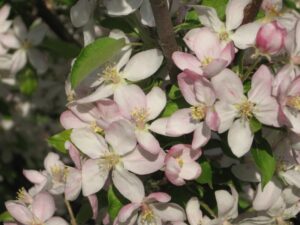This weekend marks the 92nd Apple Blossom festival and it promises to be another great event. I remember as a child watching the parades wind through the streets of Winchester as I marveled at the floats, the fancy cars, and the celebrities. One year in particular I remember catching a glimpse of President Gerald Ford near Handley High School. Some years later, it was a special gift to watch my own children react as they saw their first elephants, clowns, and acrobats at the Apple Blossom circus.

It’s a little ironic that other than the logo and some light green and pink, the actual blossoms of apples are generally forgotten. It’s just a good excuse to party. This festival, however, is different than many fall celebrations which usually highlight the ingathering of some agricultural product while “The Bloom” anticipates the hope and promise of the future harvest. If all goes well, growers can expect lots of luscious apples hanging from burdened branches that grew from those spring flowers.
Some years, however, various obstacles prevent such a harvest from materializing. Although the blossoms’ beauty and sweet aroma can and should be enjoyed in the springtime, there’s no financial reward for showy petals. What matters in the fall is the amount of fruit actually harvested.
Between bloom and harvest too much or too little rain can lower the yield and other years, a disease or insect outbreak can spell trouble for the orchardists. Some years, a late frost can severely curtail production by killing the blossoms before the fruit is even set. Careful management and good weather are both needed to result in a generous harvest.
These realities remind me of a parable Jesus told. They didn’t have apples in Galilee, but they did have figs. We aren’t told if they had fig blossom celebrations but in Luke 13 Jesus described a vineyard owner who was not happy that one of his fig trees was barren. Whether it bloomed or not, we don’t know, but Jesus did indicate that for three years it had been fruitless and the owner wanted to cut it down. The caretaker talked him into sparing it for another year to see if he could coax it into production and if not, he’d use his own Homelite to fell it.
That’s where the parable ends. Jesus leaves us wondering if that tree finally produced figs and dodged the saw or if it persisted in futility and ended up on the woodpile. He did that on purpose. He wants us to consider our own fruit production.
Some of us bloom really well. We are good at the showy parts of life with our humor, our intelligence, our athleticism, or even our beauty. Many marvel at how great we seem and applaud our public presentation. Unfortunately, these qualities don’t always translate into fruit production.
In Galatians 5, Paul lists some of the qualities of the spiritual fruit Jesus was talking about. Instead of color, flavor and texture of the apples or figs, he mentions love, joy, peace, patience, kindness, goodness, faithfulness, gentleness, and self-control as desirable life qualities. This kind of fruit is only possible if the Holy Spirit lives in us and uses the light of God’s Word, the soil of our hearts, and the water of His love to bear fruit that will glorify God and bless others.
As our valley celebrates another Apple Blossom, let’s remember that Jesus isn’t interested in our promises and appearance. He wants us to bear lasting spiritual fruit of the highest interior quality. His desire is for us to use the resources He’s entrusted to us to bring to maturity that which He’s bloomed in our lives. Let’s put a smile on our orchard Owner’s face by doing just that.
Working on fruit, George